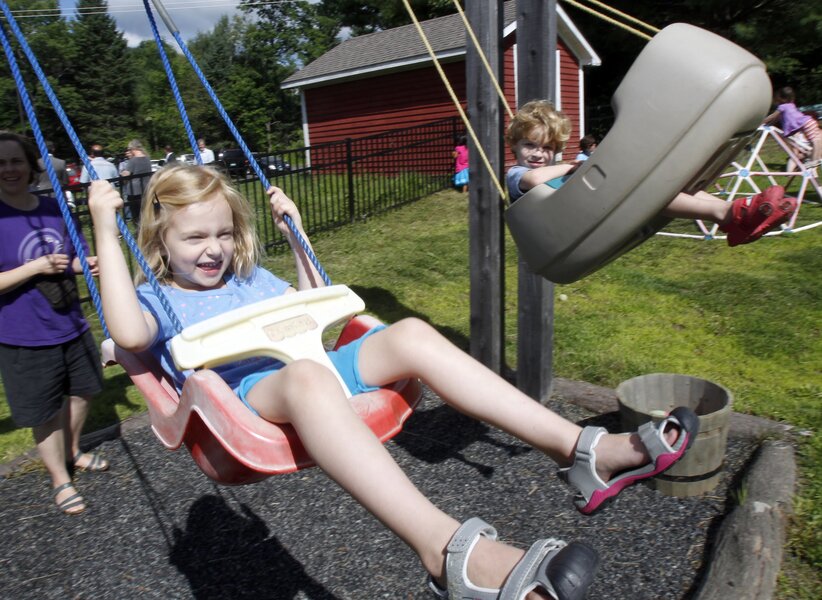Kids Count report: America's children are advancing despite the economy
Loading...
More children are attending preschool, more elementary students are reading better, and more high-schoolers are graduating on time despite the sharp economic downturn, according to a new report released Wednesday.
Yet the increase in the number of children living in poverty, and the lagging negative effects expected from state budget cuts, are prompting advocates to call for a sharper national focus on children’s well-being.
“This year’s findings reveal signs of hope in the midst of tough economic times for millions of families across the country,” said Patrick McCarthy, president of the Annie E. Casey Foundation, in a statement releasing the 2012 KIDS COUNT Data Book. The national philanthropy dedicated to children is based in Baltimore.
Policymakers and advocacy groups take note of the annual report, which the foundation has been producing using state-by-state data for more than 20 years.
The study found a 20 percent decrease in the number of children without insurance and a 16 percent decrease in the child and teen death rate.
In education, the study found:
• More preschool participation: The share of 3- to 4-year-old children not enrolled in preschool declined from 56 percent in 2005-07 to 53 percent in 2008-10. (Research has shown that at-risk children in particular improve school readiness when involved in high quality preschool.)
• Reading and math proficiency gains in public schools: The share of fourth-graders reading below proficiency in 2011 was 68 percent, down from 70 percent in 2005. In math, the share of eighth-graders below proficiency declined from 72 percent to 66 percent.
• Improved graduation rates: The share of students who did not graduate from high school on time declined from 27 percent in 2005-06 to 24 percent in 2008-09.
Improvements in children’s health and education are likely the result of a decade or more of concerted emphasis in federal and state policies, Laura Speer, a Casey Foundation associate director and co-author of the report. On the education front, the federal No Child Left Behind law’s emphasis on math and reading scores and a national movement to increase both preschool attendance and high school graduation could explain the numbers, she says. And in health, she points to improvements in car safety for kids and teens, as well as advances in medical care.
The fact that children’s insurance rates improved during the recession offers an “important lesson that those safety nets for children are critically important,” says Bruce Lesley, president of First Focus, a children’s advocacy group in Washington.
Some of the budget cuts states have made in recent years to education could show up in worse numbers in future reports, Ms. Speer says. “Hopefully economies will recover” in time to offset that, she says.
The improved indicators are encouraging, but they are offset by the sheer number of children still struggling with poverty, unstable families, and dead-end educational experiences, some advocates say.
Nationally, nearly 16 million children – 22 percent – lived in poor families in 2010, up 2.4 million from 2009. And 985,000 students did not complete high school on time in 2008-09.
“This is a very unforgiving economy. For a million students to be dropping out a year is not something to cheer about,” says Maria Ferguson, executive director of the Center on Education Policy at George Washington University. “The economic impact of not having a high school diploma is so deadly,” she says.
The center’s reports have shown that federal stimulus funding for education did help blunt some of the effects of the economic downturn, but that was a one-time infusion of cash, and states are still struggling.
One ray of hope, Ms. Ferguson says, is that the move toward common state standards and assessments could create economies of scale so that states can be more effective while reining in budgets.
Another disturbing indicator in the report, Ferguson and others say, is the continued educational gap between racial groups, which largely correlates with higher rates of poverty for African-Americans and Latinos.
While 58 percent of white fourth-graders had yet to achieve reading proficiency in 2011, more than 80 percent of their Latino, African-American, and American Indian classmates lagged in this area, the report says.
The report offers state-by-state breakdowns of its indicators. The top five states overall: New Hampshire, Massachusetts, Vermont, New Jersey, and Minnesota. The bottom five: Arizona, Louisiana, Nevada, New Mexico, and Mississippi.
Twenty-two percent of children living in poverty is “a national crisis,” Mr. Lesley says.
“In the United Kingdom they are having a national debate … about what to do about child poverty…. In the US, neither party is talking about it,” he says. “The effect of that on our future is profound.”





